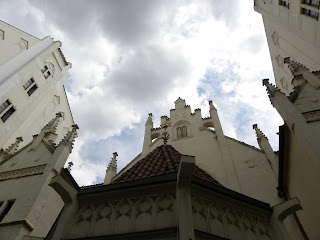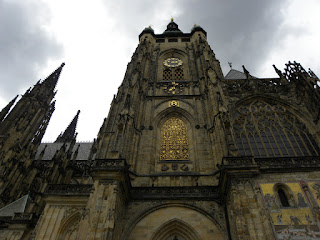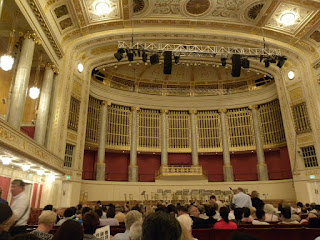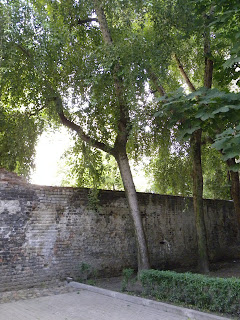When I woke up this morning, it was hard for me to remember if what happened yesterday was real or just a dream. I think I'll have the exact same feeling tomorrow morning.
Sima and Leah (Zayde's first cousins) live in a nursing home in Rishon L'Tzion, just outside of Tel Aviv. Renee (my mom's friend) happened to be going to Tel Aviv today, so it worked out that she could drive me there, and then Dov (Leah's son) would meet me and take me to meet his mom and aunt. On the way to Tel Aviv, I tried to think of all the questions I wanted to ask Sima and Leah, but I didn't know what to expect--if they would remember things about him and his family, if they knew what happened to him during the war--and besides that, I kept thinking about how crazy it was that one day I call someone and say we're probably related, and the very next day I'm going to meet him! When we arrived at our meeting spot in Tel Aviv, Dov was waiting outside his car to meet me, and the instant we met and began talking, it was like I was talking to someone I had known for years. On the way to the nursing home, he told me that his wife, Rachel, and older sister, Miriam, would be joining us there with Sima and Leah.
Shortly after Dov and I arrived at the nursing home and sat down at a table outside, Sima walked outside to join us--we hugged and she kissed me and we starting talking. Right away, she started saying how Zayde and her were like brother and sister, that before the war, she used to stay at his house in Szczebrzeszyn every summer, and after the war, they always kept in touch. She described Zayde's parents as very nice people, owners of a clothing store, who lived in a large house in Szczebrzeszyn. She said that the family used to make clothes for all the important people in the town. She remembered Zayde's 3 brothers by name (Rachmiel, Hirsch, and Yitzchak), and remembered that one of them was married with young children. After Zayde married Milka, he moved to Zamosc since her family lived there, and he had his own tailor shop. Sima said that by the time the war started, Zayde and Milka's son, Chaim, was already grown. She even remembered how Chaim was named: the same night that Zayde's maternal grandfather, Chaim, died, Zayde's son was born, so he was named Chaim after his great-grandfather.
At some point, Sima's sister, Leah, Leah's daughter, Miriam, and Dov's wife, Rachel, joined us, and they were all excited to meet me and hear what we were talking about. Leah, right when she saw me, commented on how I looked just liked Zayde (By the way, they all knew Zayde as Tewel). I told them that my dad and I had been to Zamosc and Szczebrzeszyn, and I showed Sima and Leah pictures from the center of the city. None of them had been back after the war, so they were very excited to see pictures of how the city looks today.
I asked Sima if she knew what happened to Zayde during the war. She said that when the war started, everyone knew that they had to run away somewhere, and most people went to Russia. Zayde's mother came to Sima's house and told her that the family was leaving and that she had to come with them. Sima's parents weren't home, and Sima didn't want to leave without them, so Zayde's mother went back home, her family never managed to escape, and they were all killed. Sima's family escaped to Russia, and that's how she was able to survive with her whole family. After the war, Sima's family was in Germany and heard that Zayde was still alive, so got in touch with him and then lived near each other in Germany--that's when Sima heard from Zayde what happened to everyone. Zayde stayed in Zamosc with his wife and Chaim, and at some point, Chaim was killed. Zayde's wife found out first, and she had to be the one to tell Zayde. Later, she was also killed. Then, everyone was sent to various camps, and since Zayde was a skilled worker, he worked in the camps, but only up until a certain point, when everyone was put on a train to what they understood was their deaths. Zayde jumped off the train, injured both of his legs, but managed to escape. At some point, he was caught and sent to Terezin, but he was liberated shortly thereafter.
When Sima's family and Zayde met again in post-war Germany, Sima said that Zayde had already been married to Grandma Esther and that they already had a son (Henry), and that the other was born later (Mickey). I asked Sima if she knew what happened to Grandma Esther during the war, and she said that the only thing that she knew was that she had been a Partisan (!), and that the war was an extremely difficult time for her. That's why, when she and Zayde met after the war, and they were each alone, they decided to marry and start new lives together. Sima's family moved to Israel in 1947 or 1948, and when it came time for Zayde and Grandma Esther to leave Germany, Zayde wrote to Sima asking if he should move to Israel. Sima wrote to him that she should go to America, because he would find more opportunities for work there. Ever since then, Sima and Zayde kept in touch, and when things were hard in Israel, Zayde would send a package--Miriam and Dov always remember that as children, a package from Tewel in America meant something special, and Miriam told me that she has framed pictures of herself wearing dresses that Zayde made and sent to her. When Zayde and Grandma Esther visited Israel, they spent their time with Sima's family, and when it came time for them to go back to New Jersey, Zayde would be so upset to be leaving Sima. She described him as smart, but also humble--he wouldn't try to tell you something or teach you something just to show you that he was smart.
I don't know how long we talked for, but it seemed like time just stopped and we were in a dream. I really can't describe it any other way. I brought pictures of Zayde and Grandma Esther with the American branches of the family, and they were all so interested in learning about everyone and hearing where everyone is. Dov and his wife will be in New York in September and they want to meet everyone! On one hand, it's crazy to think that from yesterday to today, it's like our family had doubled in size--but on the other hand, this whole branch of the family was always there, but somehow, our connection was broken. We all agreed that this time, the connection wouldn't be broken.
After I said goodbye (actually l'hitraot, Hebrew for "see you later") to Sima, Leah, Rachel, and Miriam, Dov and I met Dov's youngest son, Roy, for dinner. He's 23, so he's the closest in age to my brothers and me. Again, it was like talking to someone I've known for years. It's made me realize that even after years of a lost connection, years after not even knowing relatives existed, years of telling people I didn't have relatives in Israel--even after all of that, family is family.






































